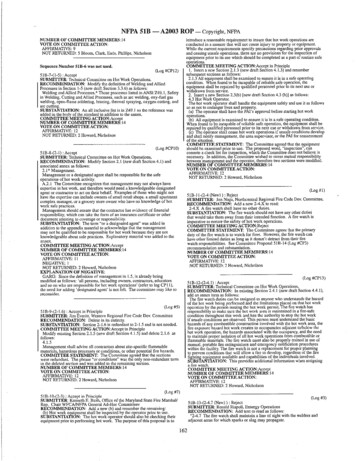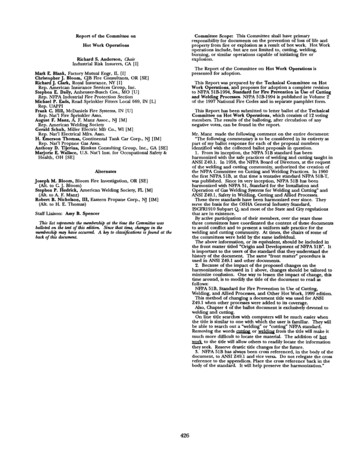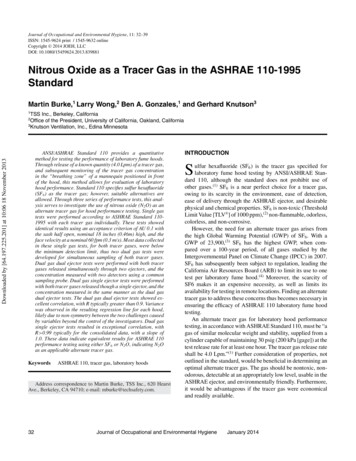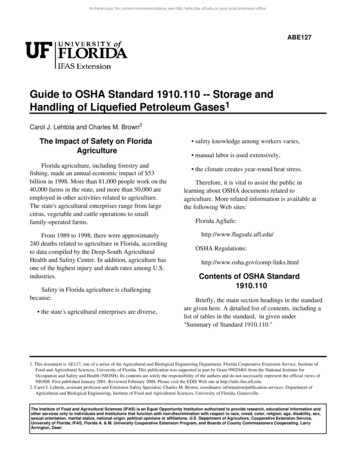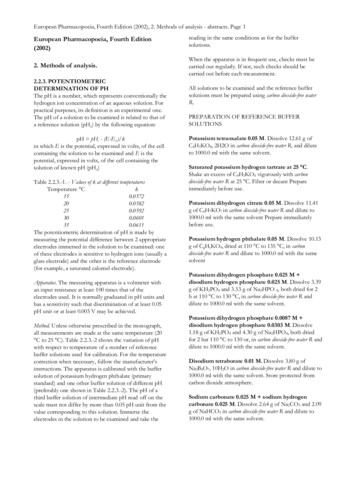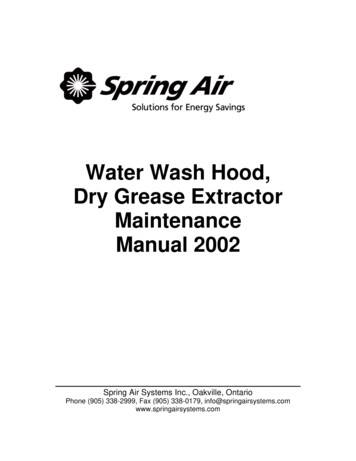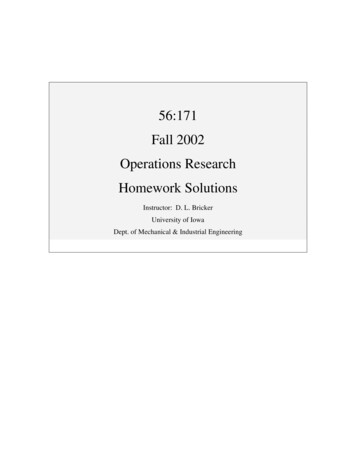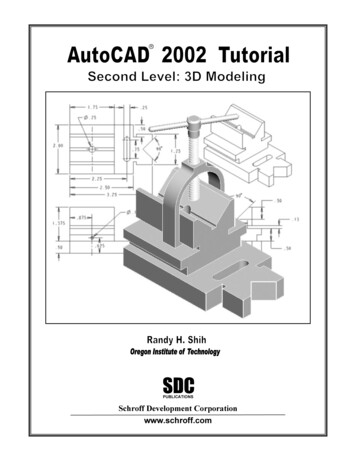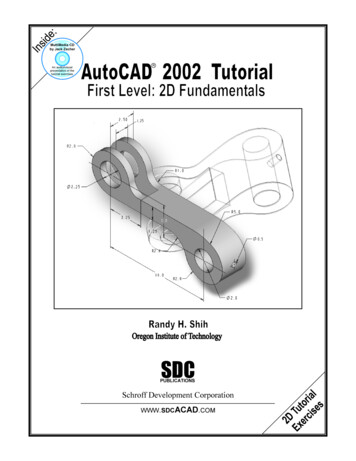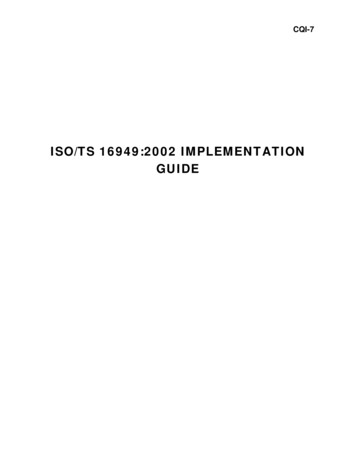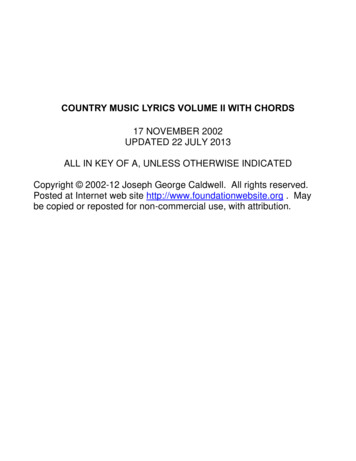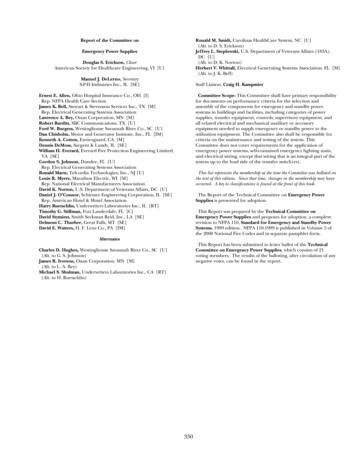
Transcription
Ronald M. Smidt, Carolinas HealthCare System, NC [U](Alt. to D. S. Erickson)Jeffrey L. Steplowski, U.S. Department of Veterans Affairs (183A),DC [U](Alt. to D. K. Norton)Herbert V. Whittall, Electrical Generating Systems Association, FL [M](Alt. to J. K. Bell)Report of the Committee onEmergency Power SuppliesDouglas S. Erickson, ChairAmerican Society for Healthcare Engineering, VI [U]Manuel J. DeLerno, SecretaryS-P-D Industries Inc., IL [SE]Staff Liaison: Craig H. KampmierCommittee Scope: This Committee shall have primary responsibilityfor documents on performance criteria for the selection andassembly of the components for emergency and standby powersystems in buildings and facilities, including categories of powersupplies, transfer equipment, controls, supervisory equipment, andall related electrical and mechanical auxiliary or accessoryequipment needed to supply emergency or standby power to theutilization equipment. The Committee also shall be responsible forcriteria on the maintenance and testing of the system. ThisCommittee does not cover requirements for the application ofemergency power systems, self-contained emergency lighting units,and electrical wiring, except that wiring that is an integral part of thesystem up to the load side of the transfer switch(es).Ernest E. Allen, Ohio Hospital Insurance Co., OH [I]Rep. NFPA Health Care SectionJames K. Bell, Stewart & Stevenson Services Inc., TX [M]Rep. Electrical Generating Systems AssociationLawrence A. Bey, Onan Corporation, MN [M]Robert Burditt, SBC Communications, TX [U]Ford W. Burgess, Westinghouse Savannah River Co., SC [U]Dan Chisholm, Motor and Generator Institute, Inc., FL [IM]Kenneth A. Cotton, Enviroguard, CA [M]Dennis DeMoss, Sargent & Lundy, IL [SE]William H. Everard, Everard Fire Protection Engineering Limited,VA [SE]Gordon S. Johnson, Dundee, FL [U]Rep. Electrical Generating Systems AssociationRonald Marts, Telcordia Technologies, Inc., NJ [U]Louis R. Myers, Marathon Electric, WI [M]Rep. National Electrical Manufacturers AssociationDavid K. Norton, U.S. Department of Veterans Affairs, DC [U]Daniel J. O’Connor, Schirmer Engineering Corporation, IL [SE]Rep. American Hotel & Motel AssociationHarry Ruetschlin, Underwriters Laboratories Inc., IL [RT]Timothy G. Stillman, Fort Lauderdale, FL [C]David Stymiest, Smith Seckman Reid, Inc., LA [SE]Delmont C. Thurber, Great Falls, MT [SE]David E. Watters, H. F. Lenz Co., PA [IM]This list represents the membership at the time the Committee was balloted onthe text of this edition. Since that time, changes in the membership may haveoccurred. A key to classifications is found at the front of this book.The Report of the Technical Committee on Emergency PowerSupplies is presented for adoption.This Report was prepared by the Technical Committee onEmergency Power Supplies and proposes for adoption, a completerevision to NFPA 110, Standard for Emergency and Standby PowerSystems, 1999 edition. NFPA 110-1999 is published in Volume 5 ofthe 2000 National Fire Codes and in separate pamphlet form.AlternatesThis Report has been submitted to letter ballot of the TechnicalCommittee on Emergency Power Supplies, which consists of 21voting members. The results of the balloting, after circulation of anynegative votes, can be found in the report.Charles D. Hughes, Westinghouse Savannah River Co., SC [U](Alt. to G. S. Johnson)James R. Iverson, Onan Corporation, MN [M](Alt. to L. A. Bey)Michael S. Shulman, Underwriters Laboratories Inc., CA [RT](Alt. to H. Ruetschlin)330
NFPA 110 — November 2001 ROP — Copyright 2001, NFPA(Log #5)110- 1 - (1-5 (New) ): Accept in PrincipleSUBMITTER: Northcentral Regional Fire Code Dev. CommitteeRECOMMENDATION: Add a new Section 1-5 to read as follows:1-5 The installation of wiring, control panels, instrument panels,and other electrical components shall be installed in accordance withNFPA 70.SUBSTANTIATION: There is not direct reference to NFPA 70 forthe wiring, etc. of electrical components for emergency and standbysystems. This proposal would place that requirement in the generalsection for everyone to see.COMMITTEE ACTION: Accept in Principle.Revise 5-12.1 to read:“The distribution and wiring systems with EPSS shall be installed inaccordance with applicable standards. NFPA 70, National ElectricalCode. (See NFPA 70, National Electrical Code.)Delete A-5-12.1.COMMITTEE STATEMENT: The committee agrees with thesubmitter’s intent but believes it belongs in the Distribution section.The appendix note is deleted because it was brought into the bodyof the document.NUMBER OF COMMITTEE MEMBERS ELIGIBLE TO VOTE: 21VOTE ON COMMITTEE ACTION:AFFIRMATIVE: 16NOT RETURNED: 5 Burgess, Everard, O’Connor, Stillman, WattersNUMBER OF COMMITTEE MEMBERS ELIGIBLE TO VOTE: 21VOTE ON COMMITTEE ACTION:AFFIRMATIVE: 16NOT RETURNED: 5 Burgess, Everard, O’Connor, Stillman, Watters(Log #4)110- 4 - (3-1.1): AcceptSUBMITTER: Northcentral Regional Fire Code Dev. CommitteeRECOMMENDATION: Revise text to read as follows:The following energy sources shall be permitted for use for theemergency power supply (EPS):a. Liquid petroleum products at atmospheric pressureb. Liquefied petroleum gas (liquid or vapor withdrawal)c. Natural or synthetic gasException:* For Level 1 installations in locations where theprobability of interruption of off-site fuel supplies is high (e.g., dueto earthquake, flood damage, or a demonstrated utility unreliability),on-site storage of an alternate energy source sufficient to allow fulloutput of the emergency power supply system (EPS) to be deliveredfor the class specified shall be required, with provision for automatictransfer from the primary energy source to the alternate energysource.Add a new appendix note to read as follows:A-3.1.1 Exception. Examples of probability of interruption couldinclude: earthquake, flood damage, or a demonstrated utilityunreliability.SUBSTANTIATION: This exception should be placed in theappendix as it is confusing in the existing text. The list is also notinclusive of many other items that could interrupt fuel supplies andshould not be included in the standard.COMMITTEE ACTION: Accept.NUMBER OF COMMITTEE MEMBERS ELIGIBLE TO VOTE: 21VOTE ON COMMITTEE ACTION:AFFIRMATIVE: 16NOT RETURNED: 5 Burgess, Everard, O’Connor, Stillman, Watters(Log #CP1)110- 2 - (Chapter 2): AcceptSUBMITTER: Technical Committee on Emergency Power SuppliesRECOMMENDATION: All of Chapter 2 (save two sentences) isnonmandatory. Either move this material to Chapter 1, which isadministrative, or make this an appendix, or rewrite as mandatory.SUBSTANTIATION: This proposal was generated as a result of aneditorial review of this document. The recommendation containsrecommended editorial changes that resulted from editing at thepamphlet stage of the last code cycle that require committee reviewand action.COMMITTEE ACTION: Accept.COMMITTEE STATEMENT: See Committee Proposal 110-53 (Log#CP22).NUMBER OF COMMITTEE MEMBERS ELIGIBLE TO VOTE: 21VOTE ON COMMITTEE ACTION:AFFIRMATIVE: 16NOT RETURNED: 5 Burgess, Everard, O’Connor, Stillman, Watters(Log #CP3)110- 5 - (3-2.1): AcceptSUBMITTER: Technical Committee on Emergency Power SuppliesRECOMMENDATION: Review text of Paragraph 3-2.1 forvague/unenforceable text (i.e., acceptable) and revise.SUBSTANTIATION: This proposal was generated as a result of aneditorial review of this document. The recommendation containsrecommended editorial changes that resulted from editing at thepamphlet stage of the last code cycle that require committee reviewand action.COMMITTEE ACTION: Accept.COMMITTEE STATEMENT: See Committee Action on Proposal110-6 (Log #6).NUMBER OF COMMITTEE MEMBERS ELIGIBLE TO VOTE: 21VOTE ON COMMITTEE ACTION:AFFIRMATIVE: 16NOT RETURNED: 5 Burgess, Everard, O’Connor, Stillman, Watters(Log #CP2)110- 3 - (2-2.4.3): AcceptSUBMITTER: Technical Committee on Emergency Power SuppliesRECOMMENDATION: Review text of Paragraph 2-2.4.3 forvague/unenforceable language (i.e., acceptable) and revise.SUBSTANTIATION: This proposal was generated as a result of aneditorial review of this document. The recommendation containsrecommended editorial changes that resulted from editing at thepamphlet stage of the last code cycle that require committee reviewand action.COMMITTEE ACTION: Accept.Revise 2-2.4.3(1) to read:“of a quality essentially equal to commercial power or acceptable forwithin the operating limits of the load.”2-2.4.3(2) to read:“within the time specified for the type and as defined in Table 22.2.”2-2.4.3(3) to read:“for a duration specified for the class as defined in Table 2-2.3.”COMMITTEE STATEMENT: See Committee Proposal 110-53 (Log#CP22).Since the ballot on this Proposal did not confirm the CommitteeAction, the Committee is soliciting public comment for review whenthe proposal is reconsidered by the Committee as a PublicComment.(Log #6)110- 6 - (3-2.1):SUBMITTER: Lawrence A. Bey, Onan Corp.RECOMMENDATION: Revise text as follows:The capability of the energy converter, with its controls andaccessories, to survive without damage from common and abnormaldisturbances in actual load circuits shall be demonstrable by tests on331
NFPA 110 — November 2001 ROP — Copyright 2001, NFPA1. Increase the reliability of the EPS, or2. Reduce safety hazards for the operator.It WILL:1. Increase the cost of generators with no offsetting benefit, and2. Increase the chances of acceptance of substandard equipment byauthorities having jurisdiction.UL first promoted UL 2200 as a standard that would “.evaluategenerators for their abilities to operate safely and reliably duringpower interruptions.” But from the start, UL has relied on scaretactics as a way to propagandize this standard—as demonstrated intheir article entitled “Can You Start Me Up?”, which appeared in Vol.7, No. 1, of UL’s The Code Authority. The article begins with thefollowing ludicrous description: “Mercy Hospital, Anytown, U.S.A.,10:37 p.m. A heavy thunderstorm shakes, rattles and rolls the entiretown. Downstairs in the hospital basement, several three-year-oldemergency power generators are poised for action. But they’ve neverbeen used in real-life situations. Not ever. Sure, they’ve been checked(one or twice) and maintained (cleaned off a few times) — but, forthe most part, they’ve sat silently, just in case. In seven minutes,power throughout Anytown will go out. Will the hospital generatorskick in, or will they go out too?” For UL to describe health carefacility EPS’s in a way that suggests most if not all EPS’s are poorlymaintained and unlikely to work as prescribed in a power outageconfirms UL has not even bothered reading NFPA 110, Chapter 6,especially 6-4 which is referred to by the Joint Commission onAccreditation of Healthcare Organizations, which has “deemedstatus” from the Health Care Financing Administration. It is thisstandard which assures an EPS is tested and maintained according tothe manufacturer’s recommendations — unquestionably the provenmethod for guaranteeing generator set reliability.UL 2200, on the other hand, cannot guarantee reliability or reducesafety hazards. UL has touted 2200 as a standard that would do justthat: increase reliability and reduce chances of injury, death andproperty damage; yet when questioned regarding details of incidentswhere compliance to UL 2200 could have had an effect related tothese issues, UL did not have an answer. This is because there havebeen no such occurrences, and with no empirical data proving aneed for UL 2200, it is untenable that the public be burdened withanother expensive standard.Far from reducing safety hazards, UL 2200 has not addressed eventhe simplest and most visible Federal standard.1910.17,Lockout/Tagout. Paragraph 1910.147(c)(2)(iii) states in part“.whenever new machines or equipment are installed, energyisolating devices for such machine or equipment shall be designed toaccept a lockout device.” If UL 2200 is supposed to be in part a safetystandard why has UL ignored a “code” that has saved more lives thanany other OSHA requirement?UL would like us to believe that if a generator has the UL 2200listing, it is set for life. In the substantiation section of Proposal 110-6,the submitter makes the statement that listing would, “.relieve(s)the authority having jurisdiction of the burden of examination ofequipment for which the authority having jurisdiction lacks theresources and facilities.” UL 2200, which was written without dueregard for NFPA 70, NFPA 110 or the simplest of Federal standards,is simply not a viable substitute for an AHJ visiting the job site andinspecting the set according to a professional engineer’sspecifications and NFPA standards. This is a dangerous proposition.UL 2200 is expensive. For those who will be paying the increased“tax” imposed by UL it’s not a laughing matter. UL has only one goalin mind.money. Unfortunately, UL has convinced one generatormanufacturer that listing their sets will give them a marketingadvantage, essentially increasing their market share—at the expenseof the American taxpayer.Additional information on UL 2200 and the opinion of other NFPATechnical Committee members, including Doug Erickson,Chairman, NFPA 110; and Hugh Nash, PE, Chairman of theElectrical Section of NFPA 99, can be found at e prototype models. or by acceptable tests on the systemcomponents as performed by the component suppliers. Whereavailable, the generator set(s) shall be listed for emergency service asa completely factory-assembled and factory-tested apparatus.SUBSTANTIATION: Underwriters Laboratories Standard 2200 hasbeen published for listing emergency generator sets for stationaryinstallations. The scope of UL 2200 is equipment intended forinstallation and use in accordance with the National Electrical Code,NFPA 70, NFPA 37, NFPA 99, and NFPA 110.Listing of generator set equipment can provide a consistent basisfor approval of equipment by the authority having jurisdiction basedon a published standard for
NFPA 110, which includes language to follow the manufacturer ’s guidelines, provides the necessary information to install and maintain the emergency generator in good working condition. Requiring UL certification would only add to the cost of the already strained budget of healthcare facilities. BURDITT: The requirement for “listing” the unit as “a completely factory-assembled and .File Size: 435KBPage Count: 33
